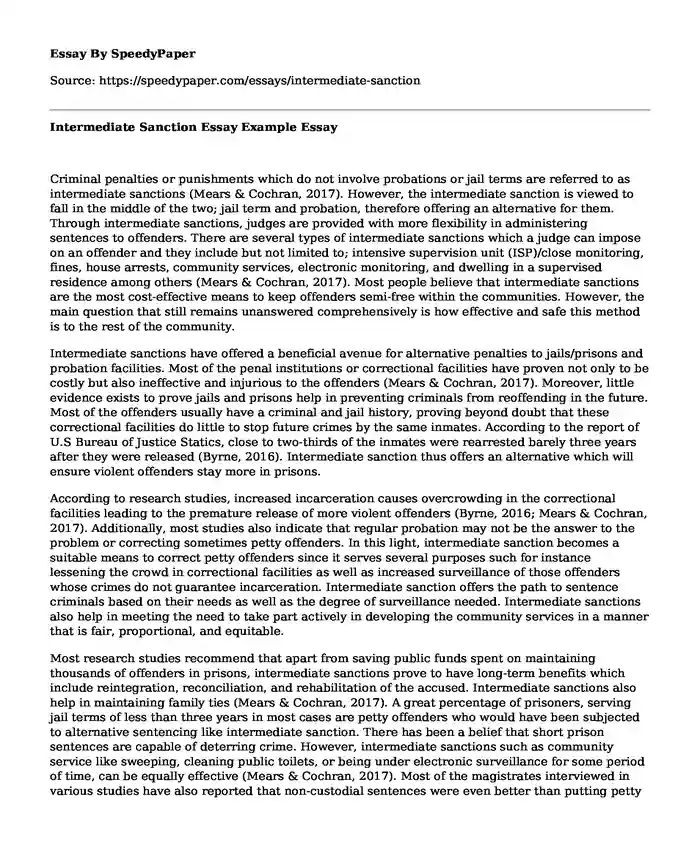
| Type of paper: | Course work |
| Categories: | Penal system |
| Pages: | 3 |
| Wordcount: | 672 words |
Criminal penalties or punishments which do not involve probations or jail terms are referred to as intermediate sanctions (Mears & Cochran, 2017). However, the intermediate sanction is viewed to fall in the middle of the two; jail term and probation, therefore offering an alternative for them. Through intermediate sanctions, judges are provided with more flexibility in administering sentences to offenders. There are several types of intermediate sanctions which a judge can impose on an offender and they include but not limited to; intensive supervision unit (ISP)/close monitoring, fines, house arrests, community services, electronic monitoring, and dwelling in a supervised residence among others (Mears & Cochran, 2017). Most people believe that intermediate sanctions are the most cost-effective means to keep offenders semi-free within the communities. However, the main question that still remains unanswered comprehensively is how effective and safe this method is to the rest of the community.
Intermediate sanctions have offered a beneficial avenue for alternative penalties to jails/prisons and probation facilities. Most of the penal institutions or correctional facilities have proven not only to be costly but also ineffective and injurious to the offenders (Mears & Cochran, 2017). Moreover, little evidence exists to prove jails and prisons help in preventing criminals from reoffending in the future. Most of the offenders usually have a criminal and jail history, proving beyond doubt that these correctional facilities do little to stop future crimes by the same inmates. According to the report of U.S Bureau of Justice Statics, close to two-thirds of the inmates were rearrested barely three years after they were released (Byrne, 2016). Intermediate sanction thus offers an alternative which will ensure violent offenders stay more in prisons.
According to research studies, increased incarceration causes overcrowding in the correctional facilities leading to the premature release of more violent offenders (Byrne, 2016; Mears & Cochran, 2017). Additionally, most studies also indicate that regular probation may not be the answer to the problem or correcting sometimes petty offenders. In this light, intermediate sanction becomes a suitable means to correct petty offenders since it serves several purposes such for instance lessening the crowd in correctional facilities as well as increased surveillance of those offenders whose crimes do not guarantee incarceration. Intermediate sanction offers the path to sentence criminals based on their needs as well as the degree of surveillance needed. Intermediate sanctions also help in meeting the need to take part actively in developing the community services in a manner that is fair, proportional, and equitable.
Most research studies recommend that apart from saving public funds spent on maintaining thousands of offenders in prisons, intermediate sanctions prove to have long-term benefits which include reintegration, reconciliation, and rehabilitation of the accused. Intermediate sanctions also help in maintaining family ties (Mears & Cochran, 2017). A great percentage of prisoners, serving jail terms of less than three years in most cases are petty offenders who would have been subjected to alternative sentencing like intermediate sanction. There has been a belief that short prison sentences are capable of deterring crime. However, intermediate sanctions such as community service like sweeping, cleaning public toilets, or being under electronic surveillance for some period of time, can be equally effective (Mears & Cochran, 2017). Most of the magistrates interviewed in various studies have also reported that non-custodial sentences were even better than putting petty offenders behind bars.
It is therefore evident that intermediate sanction is an effective method of correcting petty offenders. Additionally, keeping petty offenders in the community has no harm provided they have been proven to be nonviolent. Keeping them in the community help in rehabilitating and reintegrating them as well as ensuring they keep in touch with their family members who also play a key role in offering them moral support.
References
Byrne, J. M. (2016). Smart sentencing revisited: Assessing the policy/practice implications of research on electronic monitoring and other intermediate sanctions. Advancing criminology and criminal justice policy.
Mears, D. P., & Cochran, J. C. (2017). Progressively Tougher Sanctioning and Recidivism: Assessing the Effects of Different Types of Sanctions. Journal of Research in Crime and Delinquency, 0022427817739338.
Cite this page
Intermediate Sanction Essay Example. (2022, Mar 09). Retrieved from https://speedypaper.com/essays/intermediate-sanction
Request Removal
If you are the original author of this essay and no longer wish to have it published on the SpeedyPaper website, please click below to request its removal:
- Astrophysics Essay Sample
- Free Essay about Budgetary Process
- Essay Sample on Child Development: 3-years-old Children's Development
- Interprofessional Collaboration: Bridging the Intimacy Gap, Free Essay for Everyone
- Essay Sample: My Evaluation for Future Leadership
- Essay Sample on Healthcare Quality Benchmarking
- Essay Sample on Weis Markets and Chicago Rivet-Valuation
Popular categories




